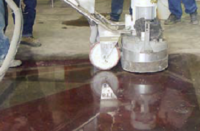I got the call the other day. This one was a little different, because the friendly customer on the other end wasn’t looking for me but to me.
Let me explain. It seems another decorative contractor had installed stamped work in her backyard and, let’s say, the quality of work was in question. She didn’t give her name, no “Hello, how is the family,” nothing. She launched right into how the low-down contractor had installed shoddy work, and she wanted my help figuring out what to do about it. I would start to answer one question and she would come right over the top with another. You see, this is part of the problem with unhappy customers – they start to see more and more “imperfections” and the unhappy list grows.
I dismissed myself from the conversation by letting her know the contractor on record had a good reputation and the discussion should be with him, not me. I also, for free, advised her to pick the two things most concerning her and stick with these items only when sitting down with the decorative contractor. I wish him luck.
You will get complaint calls regarding your contracting, and this day needs to be planned for. Your customer may have a legitimate complaint or may need some educating. Nevertheless, not responding to the complaint will only aggravate the situation. Most contractors deal with the situation only when money is held and the only way to close the books on the job is to deal with the complaint.
Decorative concrete, all types included, has many shades of gray, and this can compound the problem. I have yet to see a decorative concrete playbook of instruction that allows a customer to simply check off the steps to completion. This would make it much easier to spot what went wrong and why, but this simply does not exist. I know of no foolproof way to completely eliminate all customer complaints. However, I do have a few suggestions learned from many years in the decorative trenches.
Suggestion 1: Confront the problem, not the customer
I realize this is especially tough when you know your crew did a top-notch job and the customer is being unreasonable. I have found it works best to meet the customer on-site with pad of paper in hand to write down the concerns – as they see them. Don’t interrupt, don’t shout, don’t look at your watch, and don’t act put out. Listen hard, because you can rest assured there is a lawyer within a block and half that would love to collect some of your money.
Now is the best time to snuff out the problem before your customer gets frustrated. If some items are justified, than apologize for the inconvenience and let the customer know that you will look into it immediately. This will buy a day or two to do two things. The first is: Figure out what went wrong and what your crew will do in the future to eliminate it. The second is a detailed plan on what you will do to correct the problem and who will pay for it. I’m guessing the cost to fix is coming out of your pocket. Regardless, get the problem taken care of. If you’re dealing with a possible future problem rather than a real-time problem, give your customer a written letter acknowledging your intent to be involved if a fix is needed. Do not underestimate the power of this letter as it relates to decorative concrete issues.
Suggestion 2: Don’t blame
Did the fire-sprinkler contractor leave oil spots? Did someone walk across your work? Did your supplier send the wrong product – again? Was it windy or rainy? Did one of your men leave the job sick? Did a tool break? Did you bid the work too cheaply? Did the pastor walk down your newly stamped sidewalk? Who keeps a 100-hundred-year old tortoise in the backyard, and how did it find your fresh concrete anyway? I have had all of the above and more damage jobs and cost me money. I have prayed, cussed, yelled and begged. But the most effective response is to accept the problem as yours. Something about a guy standing tall and accepting the problem is unique in this age. Passing the buck will cause skepticism with your customer because they do not know whom to believe. The only thing your customer cares about is getting what they expected. Chalk it up to experience and move forward. Life is short and the days are long if you constantly make excuses for why your job is problematic.
Suggestion 3: Prequalify the fix
The goal here is to calm the waters, then get yourself paid. At this point, all involved acknowledge that there is a problem or concern, and you are working to solve it. You should have contacted your material supplier as well, because they will need to know if this is an isolated situation or a potential defect.
The next step depends on the complexity of your customer and problem. You may need to go as far as to write out the problem or concern and the plan of action to correct it. I like to do this in many situations, because it keeps the customer from adding conditions of payment after the corrections. Present the plan to correct, and prequalify the customer by deciding when you will get paid and at what point. You may have to leave retention on the table, but at least 90 percent should be paid if the problem is corrected. Do not start the repair until this is agreed upon. There is a long list on the Decorative Wall of Shame of contractors that have tried to rush through repairs without a solid plan.















